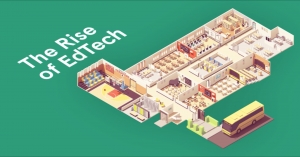The Rise of EdTech

Classrooms today look significantly different to classrooms just three years ago.
Gone are the days of the lone computer in the corner. Today’s classrooms boast laptops, tablets, smartphones and some even have Interactive Flat Panel Displays (IFPDs).
The drivers for this are tech savvy pupils. We now live in an age where even toddlers are familiar with how to use tablets, and before long virtual and augmented reality will become their norm.
With the rise of ever more technically fluent children and teenagers comes many concerns about the appropriateness of the internet and other technologies in academia. Parents and teachers alike have voiced concerns about the role technology should play in a child’s learning.
This is what I’m really interested in. To what extent do you think technology should shape learning? How willing are you to adapt and adopt?
The EdTech boom
In their 2020 EdTech vision, The Education Foundation says, “There are so many reasons to be optimistic and to celebrate EdTech – education and learning technology – across our nation. Educators and young people are pragmatic and often behave with realism about technology that can sometimes seem to be missing in some debates”.
In recent years there has been several developments in technology aimed to help children collaborate, instead of working alone.
An Interactive Flat Panel is one technology that aims to get children working together in the classroom. The benefit of this was explored by the University of Illinois study that found children who took part in group learning develop better decision making skills.
Teaching with technology
Technology should be an addition to traditional teaching, enhancing it for both students and teachers - never substituting it. Much like in our world, emails will never replace the impact you get from a face-to-face meeting with you candidates.
One way it is shaping new learning is by easing the burden of lesson planning.
Lesson planning and preparation, as many teachers will know, takes up a large part of your time.
Technology such as Promethean’s ClassFlow lets teachers plan highly interactive, multi-media-laden lessons and can help make assessments and assignments just by answering questions about the subject you intend to teach. These can then be shared both in and out of classroom.
Not only can ClassFlow support lesson planning but it can also give teachers the chance to use real-time feedback, allowing them to gauge how well a class comprehends a lesson, even pinpointing student’s individual understanding. This allows a teacher to give extra support to students who are having difficulty grasping the subject, or even readdress points to the whole class if failure to understand certain areas is across several students. This then gives the school an improvement in overall grades.
One of the highlights of using technology in teaching is that it allows for education to continue outside of the standard classroom hours, releasing the boundaries by time in class.
With technology students can go over lessons in their own time from home to boost their understanding of the topics covered. Laptops, smartphones and tablets will all become key to learning remotely.

Heightened collaboration
Technology is also encouraging students to work more collaboratively. IFPDs
let students contribute content, engage with each other, and even help shape future lessons. Technology allows students to create new ways to approach problem solving along with working together with fellow students, which will become an essential skill in their careers going forward.
Whilst textbooks are still a key part of learning in classrooms across the country, it’s important to acknowledge that students rely on the internet more and more for researching and supporting their learning.
With exciting interactive apps and touchscreen display units, learning is presented in a far more interesting and engaging way than ever before. Students can download homework straight from a portal and contact a teacher outside of hours for extra support if need be.
Teachers should understand, accept and encourage technology in learning as it’s to the benefit of students, teachers and society at large.
I’d love to get your thoughts on this hot topic.



